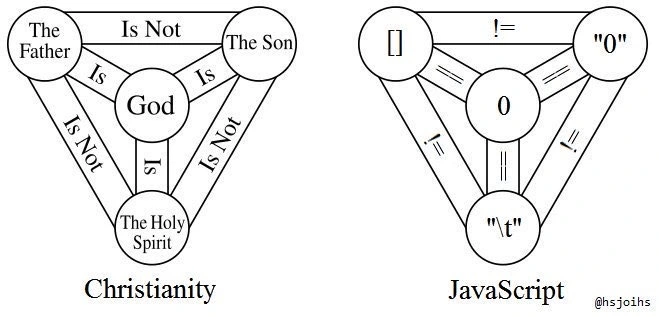deleted by creator
by not ever using == and !=, but only === and !==
Because in reality you’re not doing stupid stuff like that in the image. And using Typescript definitely helps.
However I’m always annoyed that the month parameter when constructing a date object is 0 based. So 1st of Jan is
new Date(2024, 0, 1)deleted by creator
Looks confusing at first, but I found it nice for accessing a month array.
const months = ["Jan", "Feb", ...]; months[0] === "Jan"; const label = months[date.getMonth()];
Typescript :)
Yep. It’s the only reason I’m still somewhat sane.
I got by without it for years, but not that I have it I have no idea how I did it back then.
By banishing the bad part of the language with linter.
For instance, standard eslint preset has rules that enforce usage of
===, https://eslint.org/docs/latest/rules/eqeqeqThese rules often come with project starter template
And typescript is basically just a linter on steroids
almost forced to for web front end. why you would use it anywhere else, however, i will never know
The same reason people drive their car to buy groceries.
You bought it for something where it was the only option, driving 30km to work everyday. But ever since you got it, the trip to the super market is kinda too hot in the summer and too cold in the winter and what if you spontaneously need to buy more than expected?
People learn it for front end dev, and then they use what they know for back end too.
Ikr? English is hard /s
I still don’t understand the
===operatorEdit: I think a more type strict
==? Pretty sure I understand the point of typescript now.So in JavaScript there’s the assignment
=and the comparator is
==Since there’s no types JS will do implicit conversion before comparison when using == in a case like this
if(false == '0'){ //this is true }But with === it doesn’t. It means literally compare these
if(false === '0'){ //this is false }else{ //so this will execute instead }But this, however, will
var someState = false; if(someState === false){ //this is true }deleted by creator
Np. closed as duplicate
> 1 == 1 true > 1 == '1' true > 1 === '1' false(from node REPL)
Basically it’s the real equals sign

The short answer is that your language needs === when it fucked up the semantics of ==, but it’s also too popular and you can’t fix it without breaking half the web.
Or when it is something like Prolog, where equality is inherently a messy and complex concept.
It’s like the ==, but there’s one more =
JS’s
==has some gotchas and you almost never want to use it. So===is what==should have been.All examples are true:
"1" == true [1, 2] == "1,2" " " == false null == undefinedIt isn’t that insane. But some invariants that you may expect don’t hold.
"" == 0 "0" == 0 "" != "0"One neat feature is you can compare to both null and undefined at the same time, without other falsey values giving false positives. Although that’s not necessary as often now that we have nullish coalescing and optional chaining.
I just tested and Terser will convert
v === null || v === undefinedtonull==v. Personally I would prefer to read the code that explicitly shows that it is checking for both and let my minifier/optimizer worry about generating compact code.Try changing to const === variable. That’s most likely what’s it doing to minimize the risk of accidental assignment.
Wut? This is an automated optimizer. It is not worried about accidental assignment.
I agree it shouldn’t. But I’ve seen linters that automatically change it since they seem to be forcing practical conventions sometimes.
Linters and minifers are completely different tools.
It’s also important if you’re checking hashes (at least, it was - if you’re using correct hashing algorithm that isn’t ancient, you will not have this problem).
Because if you take for example “0e462097431906509019562988736854” (which is md5(“240610708”), but also applicable to most other hashing algorithms that hash to a hex string), if(“0e462097431906509019562988736854” == 0) is true. So any other data that hashes to any variantion of “0e[1-9]+” will pass the check, for example:
md5("240610708") == md5("hashcatqlffzszeRcrt")that equals to
"0e462097431906509019562988736854" == "0e242700999142460696437005736231"which thanks to scientific notation and no strict type checking can also mean
0462097431906509019562988736854 == 0242700999142460696437005736231
which is
0 == 0`I did use md5 as an example because the strings are pretty short, but it’s applicable to a whole lot of other hashes. And the problem is that if you use one of the strings that hash to a magic hash in a vulnerable site, it will pass the password check for any user who’s password also hashes to a magic hash. There’s not really a high chance of that happening, but there’s still a lot of hashes that do hash to it.
that is terrifying
If you’re checking passwords, you should be using constant time string checking, anyway.
More likely, you should let your bcrypt library do it for you.
==but for JavaScript. What you don’t understand is the==of JavaScript.The other comments explains it in pretty good detail, but when I was learning my teacher explained it sort of like a mnemonic.
1 + 1 = 2 is read “one plus one equals two”
1 + 1 == 2 is read “one plus one is equal to two”
1 + 1 === 2 is read “one plus one is really equal to two”
And you hit the nail on the head, is that === is type explicit while == is implicit.
I’d use something like:
= becomes
== equals
=== is identical to
It’s funny how everyone thinks “equals” in this context should be “identical to” when, in normal language, it doesn’t really mean that at all!
Like
==but more strict. The==operator will do type conversion, so0 == ''will actually be true, as an example. Sometimes (honestly, most times) you may want to compare more strictly.See this StackOverflow answer: https://stackoverflow.com/questions/359494/which-equals-operator-vs-should-be-used-in-javascript-comparisons
You don’t need Typescript, you need an linter (eslint).
===is your basic equality like most languages.==will implicitly cast type.The breakdown is here: https://262.ecma-international.org/5.1/#sec-11.9.3
Modern JS says to never use
==unless you’re comparing againstnullorundefined.deleted by creator
JS devs should have a font that turns == into ≈.
I wish the assignment operator wasn’t the equal sign.
x 👈 5Ok deal, but that means we need to change the equality operator to 👉👈
You sonnofabitch I’m in!:-P
x 🔫 5the pew pew principle /s
Interpreter: Wait, x is 5?
This code: Always has been.

It is now, if you know what’s good for you.
:=That’s delayed assignment.
procrastination assignment
In Haskell, it’s the same as the mathematical
=symbol.
ChatGpt: 1+1≈2
Reddit: 1+1=your muther (sic, x2)
X: 1+1≈we should violently overthrow the government
4chan: nvm, I don’t want to get banned for saying this one
4chan: “Gamer words”
No, that’s Discord 🙃
cries in PHP
I also came to represent my php breathren.
1+1====2!← dreamberd developer
Basically Java in a nutshell
eight equals equals equals equals equals equals equals equals equals capital d tilde tilde
it depends on what your definition of is is
it depends on what your definition of is is
parseInt(0.00000000005)
5
classic
Mathematica also has an
===operator. And:=.It’s also very language specific, like Pascal/Delphi also have “:=” for assignments and “=” for comparison, etc
That makes much more sense than the other way.
What does the walrus operator do?
I think it’s called ‘delayed assignment’. So it is almost like
=, but you can use arguments to define functions,f[a_]:=a+2.
====when== same (after magic) === same and same type (in Javascript) ==== same and same type and same actual type (in the backend before conversion to JSON) ===== same and same type and same actual type and same desired type (what the customer wanted)Lol
Lolololol
As a backend developer i still dont know a shit what that means
In javascript, === does not perform type coercion when checking for equality
Because in JS:
1 == "1" // true 1 === "1" // false
Don’t forget that
_.isFinite('1')returns true ;)1 + false ? (I have no idea in which order JS would evaluate things as I rarely have to touch that language much anymore)





























